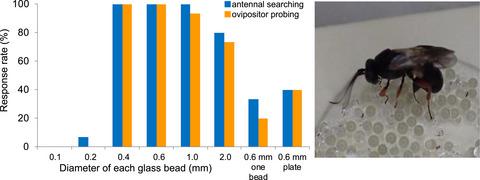当前位置:
X-MOL 学术
›
Entomol. Exp. Appl.
›
论文详情
Our official English website, www.x-mol.net, welcomes your feedback! (Note: you will need to create a separate account there.)
Host recognition by the egg‐larval parasitoid Chelonus inanitus : effects of physical and chemical cues
Entomologia Experimentalis et Applicata ( IF 1.9 ) Pub Date : 2020-10-01 , DOI: 10.1111/eea.12971 Beniha Ohsaki 1 , Takaaki Shingyouchi 1 , Yukie Sato 2 , Yooichi Kainoh 2
Entomologia Experimentalis et Applicata ( IF 1.9 ) Pub Date : 2020-10-01 , DOI: 10.1111/eea.12971 Beniha Ohsaki 1 , Takaaki Shingyouchi 1 , Yukie Sato 2 , Yooichi Kainoh 2
Affiliation

|
Parasitoid wasps are widely used as biocontrol agents. For successful deployment, it is important to know how they search for and recognize their hosts. They often use chemical cues in host searching and recognition. Little attention has been paid to the use of physical cues, particularly when combined with chemical cues, though a combination of cues may improve searching efficiency. Chelonus inanitus L. (Hymenoptera: Braconidae) is a solitary, egg–larval parasitoid wasp that parasitizes various lepidopteran species, including serious crop pests. In this study, effects of physical and/or chemical cues on host recognition were investigated in C. inanitus by observing its antennal searching, ovipositor probing, and the duration of arrestment. In a physical cue test, egg‐mass models with glass beads differing in size were used, and a single‐egg model with a specific size of bead. Egg‐mass models with beads of 0.4–1.0 mm in diameter arrested C. inanitus, in accordance with egg size and arrangement of the host. In a chemical cue test, extract from egg masses of the host Spodoptera litura (Fabricius) (Lepidoptera: Noctuidae), equivalent to half of a host egg mass and extract diluted 100‐fold were used, and the undiluted extract stimulated C. inanitus. Untreated egg‐mass models (0.2‐mm‐diameter glass beads) and diluted egg extract arrested C. inanitus less effectively; however, when glass beads were treated with the diluted extract, arrestment increased to the same degree as the undiluted extract. These results suggest that C. inanitus uses both physical and chemical cues to recognize eggs of its host, S. litura, and that these stimuli act synergistically.
中文翻译:

卵幼虫寄生物 Chelonus inanitus 的宿主识别:物理和化学线索的影响
寄生蜂被广泛用作生物防治剂。为了成功部署,了解他们如何搜索和识别他们的主机很重要。他们经常在宿主搜索和识别中使用化学线索。很少有人关注物理线索的使用,特别是当与化学线索结合时,尽管线索的组合可能会提高搜索效率。Chelonus inanitus L.(膜翅目:茧蜂科)是一种独居的卵-幼虫寄生蜂,寄生于各种鳞翅目物种,包括严重的作物害虫。在这项研究中,通过观察 C. inanitus 的触角搜索、产卵器探测和逮捕的持续时间,研究了物理和/或化学线索对宿主识别的影响。在物理线索测试中,使用了具有不同大小玻璃珠的蛋质量模型,和具有特定大小珠子的单蛋模型。直径为 0.4-1.0 毫米的珠子的卵质量模型根据卵的大小和宿主的排列阻止了 C. inanitus。在化学线索测试中,使用宿主斜纹夜蛾(Fabricius)(鳞翅目:夜蛾科)卵块的提取物,相当于宿主卵块的一半,提取物稀释 100 倍,未稀释的提取物刺激 C. inanitus。未经处理的卵块模型(0.2 毫米直径的玻璃珠)和稀释的卵提取物对 C. inanitus 的抑制效果较差;然而,当用稀释的提取物处理玻璃珠时,阻滞增加的程度与未稀释的提取物相同。这些结果表明 C. inanitus 使用物理和化学线索来识别其宿主 S. litura 的卵,并且这些刺激协同作用。
更新日期:2020-10-01
中文翻译:

卵幼虫寄生物 Chelonus inanitus 的宿主识别:物理和化学线索的影响
寄生蜂被广泛用作生物防治剂。为了成功部署,了解他们如何搜索和识别他们的主机很重要。他们经常在宿主搜索和识别中使用化学线索。很少有人关注物理线索的使用,特别是当与化学线索结合时,尽管线索的组合可能会提高搜索效率。Chelonus inanitus L.(膜翅目:茧蜂科)是一种独居的卵-幼虫寄生蜂,寄生于各种鳞翅目物种,包括严重的作物害虫。在这项研究中,通过观察 C. inanitus 的触角搜索、产卵器探测和逮捕的持续时间,研究了物理和/或化学线索对宿主识别的影响。在物理线索测试中,使用了具有不同大小玻璃珠的蛋质量模型,和具有特定大小珠子的单蛋模型。直径为 0.4-1.0 毫米的珠子的卵质量模型根据卵的大小和宿主的排列阻止了 C. inanitus。在化学线索测试中,使用宿主斜纹夜蛾(Fabricius)(鳞翅目:夜蛾科)卵块的提取物,相当于宿主卵块的一半,提取物稀释 100 倍,未稀释的提取物刺激 C. inanitus。未经处理的卵块模型(0.2 毫米直径的玻璃珠)和稀释的卵提取物对 C. inanitus 的抑制效果较差;然而,当用稀释的提取物处理玻璃珠时,阻滞增加的程度与未稀释的提取物相同。这些结果表明 C. inanitus 使用物理和化学线索来识别其宿主 S. litura 的卵,并且这些刺激协同作用。



























 京公网安备 11010802027423号
京公网安备 11010802027423号